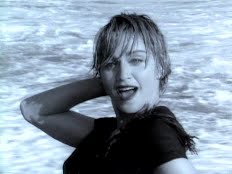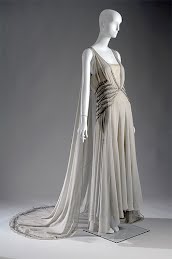Cherish the [Pandora] joy
My Pandora subscription has gone largely unused, though-- the truth is, I just am not as keen to the process of "discovering" new music as I was back in the halcyon days of high school and college, when I'd rummage through BitTorrent for hours finding new stuff.
But! I fell in love with Pandora in earnest for the first time Sunday night, when it dawned on me that there is a place for its technology in my musically unadventurous life. In a moment of clarity, I totally hit the jackpot when I formed a station based on Madonna's 1989 hit Cherish.

Just to jostle your memory: Screenshot from Madonna's Cherish video, shot by Herb Ritts
I mean, I kind of feel like I'm gaming the system by not using Pandora to find cool new fledgling artists and albums-- the Cherish station is 100% old songs that I know every word to but would never think to download. Am I the last person to the Pandora party to use it like this?
Well, seriously: If you haven't already, make your own station based on Cherish and try to tell me it's not the most fantastic thing to happen to your guilty pleasure cortex since Beyonce's Single Ladies video debuted last month.
Chic Chicago
HEY! Before you yawn and navigate away from this page, hear me out. This museum was awesome—small enough to be digestible, and full enough to be fascinating. The permanent collection includes the bed in which Abraham Lincoln died and an original waitress’ outfit from the first Playboy Club—dangerous AND sexy!
I particularly loved the “Chic Chicago” exhibit, which runs through July 26th 2009. It’s a collection of more than 60 couture outfits worn by Chicago society women from 1861 to 2004, and I would highly recommend it to anyone, regardless of his or her interest in fashion. It's a remarkably well put-together exhibit, and chock full of interesting information about the outfits on display and the women who wore them.

A gown designed by Madeleine Vionnet; worn by Mrs. Potter Palmer II when she was presented to the Queen of England in 1938.

A gown (that weighs 17 pounds!) designed by Charles James and known as the "Butterfly"; Worn by Mrs. John V. Farwell III in 1954.
We weren't allowed to take photos in the gallery, but I found a couple from the exhibit's opening soiree posted online (here and here you can see the photos and quotations I mentioned.) I wonder if the socialites in the foreground of these photos were inspired at all by the exhibit's background to think about where their own clothes came from?
The Sign*
Once upon a time in 1994, a group of JPMorgan bankers during an off-site weekend in Florida ("think yacht parties, bikini models, $1,000 bottles of Cristal") came up with "credit default swaps" as a bold way to protect themselves from loan defaults and free up capital on their balance sheets.
"Within a few years, the credit default swap (CDS) became the hot financial instrument, the safest way to parse out risk while maintaining a steady return.
'I've known people who
worked on the Manhattan Project,' says Mark Brickell, who at the time
was a 40-year-old managing director at JPMorgan. 'And for those of us
on that trip, there was the same kind of feeling of being present at
the creation of something incredibly important.'
Don't ask me how a guy who was 40 in 1994 "knew" people on the Manhattan Project, because I have no idea. The point is, everyone in the finance world in the mid-90s saw the proliferation of credit default swaps as a major, game-changing thing.
Now, check out this chart of the Dow Jones Index from 1958 until 2008:

Oh, hello there 1995! And hello there, subsequent explosive growth that was hardly harnessed by the tech bust or 9/11!
Of course, many banks have now learned the hard way that no matter how much they dice it up and sell it off, risk is still risk. And loan defaults are very bad things that are *very* difficult to fully escape.
So: If that Cristal-fueled weekend in Florida never happened, where would the DJI be today? Based on the trajectory up to then, and using my highly sophisticated "finger tracing" method, I'm going to say around 7000 points. Is that the "bottom" we're all looking for?
I'm actually asking, because I really have no idea. But it makes sense to me.
*Yep, the title is a reference to Billboard's #1 single in 1994, by Ace of Base. Hey, if we're going back to the mid-90s anyway, I say let's go all the way. Flannel shirts, 90210, and "Clueless," anyone?

Ha, well, let me know.
Real talk from Maria Bartiromo
Dressed conservatively in a khaki Escada pantsuit, with a green T-shirt and burgundy Manolos, [Maria Bartiromo] seems not to notice the women in the tiny dresses as she stops to give her autograph to an elderly gentleman visiting the exchange. She thanks him and turns to climb the stairs to CNBC’s mezzanine studio when a Fox correspondent rushes up to her.
She is wearing towering heels, tons of makeup, and a scarlet dress so tight you can see her underwear line and unbuttoned to expose her black lace bra. “Hi, Maria!” she shrieks. Maria’s eyes pop open, but then she smiles and kisses her. It’s only later that she says she was “taken aback.” The Fox reporter is a friend, and insisting that her name not be published, she says, “I did tell her, ‘Don’t ever show up here with your skirt up your butt and your shirt down low like that.’ I said, ‘It’s a distraction, it’s ridiculous, and it’s not what you want.’ I don’t know who’s telling her to do this, [but] there are a lot of women doing that.”
As someone who goes to a lot of financial industry events, I can attest to the fact that a lot of women are indeed doing that-- especially in Silicon Valley, it seems.
Maria, by the way, is obviously aware of her looks and uses them to her advantage in her career-- she has made moves to trademark the term "Money Honey," after all-- but she knows where to draw the line between being feminine and attractive and being just plain unprofessional. I love that in this interview, Maria calls a spade a spade-- and puts her remarks on the record with the VF writer.